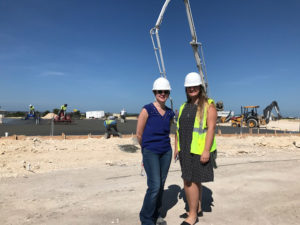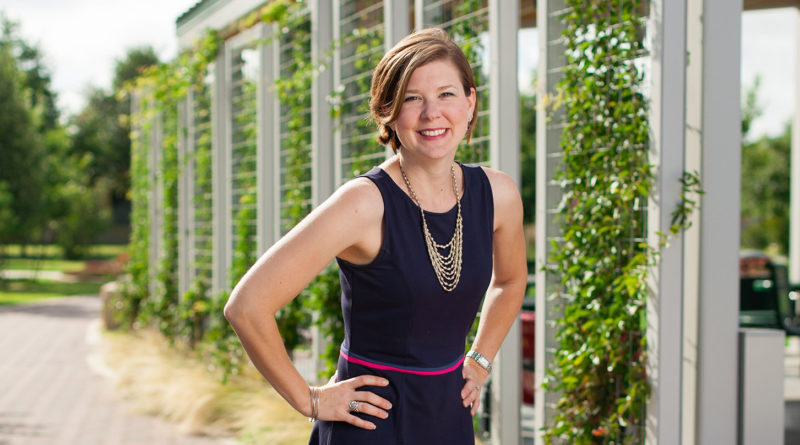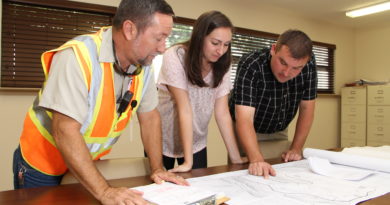Designing woman
Kelly Garcia part of a growing group of female architects
Story by Catherine Hosman
Photos by Julie Doughty
Architect Kelly Garcia welcomes her guest into the meeting room of the Neal Architectural Group in Temple.
Books on architecture line tops of tables and bookshelves. A collection of model heavy equipment trucks sits on top of a bookcase. Blueprints are spread out on work tables or are rolled up and placed in containers like umbrellas collecting in a can waiting to be pulled out and opened. There is a fragrance of freshly cut wood in the room, part of the ambiance or a subtle power of suggestion?

Architecture is a male-dominated profession — about 25 percent of all architects are women. But it is slowly changing as more women enter the field. Kelly, 38, is part of that growing group.
However, becoming an architect isn’t easy, regardless of gender.
“Our architecture class had 100 or more people. We lose a lot of students. It’s a very intense program. It is time demanding,” said Kelly, who graduated from Texas Tech in 2003 with a master’s degree in architecture.
At the beginning of her freshman year at Texas Tech, the assistant dean told the students to look to their right and left. “‘One of three of you will make it to graduation’ he told us,” Kelly said.
Driven by pure determination, Kelly made it. “I had no clue what I would do if I didn’t do architecture,” she said.
She began her post-graduate architectural career with HKS, a firm in Dallas. She was on the design group team that worked on projects ranging from “small medical office buildings to massive casinos.”
She was the architectural lead for Texas Women’s University Institute of Health and Science in Dallas — a project she holds especially close to her heart.
“It was the first project I ran start to finish,” she said. “I drew the concept, floor plans, elevation — I was the lead architect on that project.”
While she tries not to get too attached to her projects “because plans change nine times out of 10 and it usually turns out better,” it is difficult. “They are your babies. If I drive down a road and see a project, I say ‘That’s my building.’”
In 2010, Kelly was hired as an architect with the Department of Veterans Affairs. She worked in San Antonio for three years before coming home to Temple as staff architect for the Olin E. Teague Veterans Medical Center.
“I got married, had kids and decided to move back to Temple because it’s a great place to raise kids,” said Kelly, whose husband, Andrew, is the associate director at the VA hospital. She was part of the team that designed the new Surgical Intensive Care Unit and worked on renovations throughout the facility.
Kelly returned to the private sector when she joined the Neal Architectural Group in 2017.
Introduction to architecture
Kelly, a Temple native, said her passion for architecture began in childhood. She recalls a family vacation to Louisiana with her parents, Bill and Lynda Stokes, and brother, Brian. Her father took them to tour a local plantation and main house. “Everywhere we went he pointed out the architecture,” she said.
This early introduction to architecture stirred her imagination. She would play with Legos as a kid and remembers watching her brother building structures and trying to mimic his designs. “He’s the artsy one. I can look at something and build it with Legos.”
Kelly learned about drawing house plans by looking at home design magazines. When her high school sophomore geometry teacher gave her class a project to write and draw a house plan, she knew where to start.
“I had the graph paper, I would draw, erase and redo,” she said, adding that her dad, a banker by profession, but an “armchair architect,” had drafting tools and templates that allowed her to draw the tiniest details on the plan. “I created a custom-designed house with three or four bedrooms and two or three baths. Before I turned it in, I was always tweaking. What can I do to make it better? I’d change this, tweak that.”
At 16, she realized she drew “what my dream house would have been.” That sophomore geometry project set in motion her future in architecture.
Initially, she considered Texas A&M–College Station. Her parents were avid Aggie fans and attended sporting events. Kelly had cousins attending Texas Tech. She learned they had a good architectural school, so she applied at both universities to see which one would be the best fit. She was accepted by both and chose Texas Tech.

Timeless craftsmanship
Kelly spent a semester in Italy studying architecture. She toured Vicenza, Venice, Rome and most towns in between. “There was a craftsmanship we don’t see any more,” she said.
Her favorite examples of historical architecture, however, are the intricate details of ancient Egypt and India. “How did they do that? The caring and detail of India arches is stunning,” she said.
That was a time when craftsman carved and chiseled their design into buildings, Kelly said. When cities began to rise during the late 19th and into the early 20th Century, handmade bricks were stacked one at a time by masons on scaffolds, creating buildings with three-foot thick walls. Today, modern buildings rely on technology to get the same effect.
“Style-wise history tends to repeat itself,” she said. “Even in modern architecture you can find some historical elements that are modernized to use new material. Today we still use brick and stone as a veneer with architectural metals. We couldn’t do what we did before.”
Kelly said the labor cost of doing what brick masons did years ago would be too expensive. “Today builders want their projects built in six months,” she said. “It still looks good. Brick and stone are still in use. Traditional would be all brick. Today modern is brick with metal veneers, different veneers.”
Approaching a new project
When approaching a new project, whether it is from the ground up or a renovation, Kelly said the team always tries to follow the wishes of owners and builders, if feasible.
“Our duty is to educate them on what would work better — a new build or renovations,” she said. “Sometimes we plan a project from the floor up. We play with designs, find out the specific material they want to use. Some still want the Texas feel, but a little more modern. Instead of just limestone, we use Cor-Ten, a metal in the design.”
Because this is Texas, solid white limestone is readily available. “Add in metal, change up some of the metal roof details, shape of the roof line — this can change the look of a building,” she said.
“Some properties you work on take a year or two. Some go quick. Working on an 80,000-square-foot building takes a year to design, another year for construction. Before that they determine what they want. It could take two to three years to get completed.”
Budget is always the No. 1 priority she said. “With the cost of everything rising in the area — steel, labor, a shortage of laborers, to get laborers you have to pay more — this creates construction challenges. When we give the client the cost, it is more than what they wanted. This leads us to do value engineering, finding a substitute.”
Finding a substitute does not mean less quality in a building. “We are never going to compromise integrity of structure, safety, health and welfare. We always have the safety of the public in mind. The exterior may change but the integrity remains.
“I would like to see attention to detail come back,” Kelly added. “It makes the personality of our buildings and I think we are losing that. As people become budget conscious value engineering comes in. With technology some details can be salvaged. We need to bring back craftsmanship at an affordable rate.”




